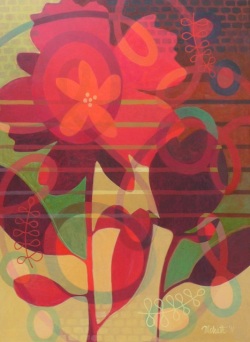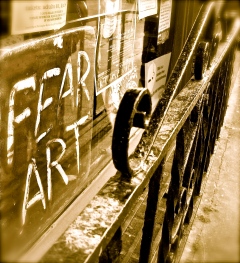Though our time in the cities we visited on our cross-country tour was short, we managed to hit a couple of wonderful, yet very different museums along the way. In Tulsa, we spent a few hours exploring the Philbrook Museum of Art.

Front facade of the Philbrook Museum of Art
My Jacksonville readers will be familiar with the Cummer Museum of Art in Jax. The Philbrook is, to me, like the Cummer on steroids. Like the Cummer, the Philbrook was once a private residence, which was donated to the city of Tulsa by its owners, oilman Waite Phillips and his wife Genevieve. Once we entered the museum doors, we found ourselves in a gorgeous, domed center hall, light streaming through the oculus in the center of the dome.

Center hall at the Philbrook

Philbrook oculus
Just walking the halls of this Renaissance style villa, built in 1927 and designed by architect Edward Buehler Delk for the Phillips as “a place where there two children could entertain friends” ( Imagine the sleepovers you could have! ), is a pleasure in itself.

Corridor at the Philbrook
The museum houses a varied and extensive permanent collection of art, ranging from African & Asian collections, Native American art to Italian Renaissance and a surprising and delightful modern collection.

Bougereau at the Philbrook, a favorite artist of the Frenz's

Lovely little Picasso at the Philbrook

Fabulous modern design collection at the Philbrook
While the museum collections are enjoyable, it is the museum grounds that really steal the show. Though we visited on a gray and rainy day, it didn’t stop us from exploring the extensive gardens behind the museum. The original formal gardens extend from the rear colonnade of the museum down to the tempietto. Let’s take a little walking tour..

Rear collonade at the Philbrook

View from the colonnade down to the tempietto

Wonderful stepped fountain

Beautiful, naturalistic water feature

No formal garden is complete without a koi pond!

View from the tempietto back toward the museum

Yours truly in the tempietto ( wouldn't this be a romantic spot to pop the question? )

Contemporary sculpture walk beyond the formal gardens
Let’s switch gears now, fast-forward through another 12 hour day on the road and pay a little visit to Denver. While in the mile-high city, we spent some time downtown including a tour through the Denver Art Museum. While the Philbrook is classically ornate, the DAM’s Hamilton Building, where we spent our time, is splendidly contemporary. Designed by Daniel Lubeskind, the structure represents the Rocky Mountain peaks surrounding Denver.

Denver Art Museum
We started at the top and worked our way down, discovering lots of fun & interesting contemporary work along the way.

Noguchi sculpture and Motherwell painting **Sidenote: Motherwell was born in Aberdeen, WA, the town where we are living for the summer.

Ceramics at DAM
Did you notice in the pictures above how the walls are slanted? The angled walls created a very interesting visual space, especially in the 4th floor gallery where they were prominent. They were a bit disconcerting when walking down the main stairs, though!

Artist: Mark Tansey
We were all fascinated by the piece above, by Mark Tansey. Another highlight was the Fox Games installation by Sandy Skoglund. I first saw Skoglund’s work in Jacksonville and am always fascinated by the environments she creates.

Fox Games by Sandy Skoglund
And there was just something about “Minotaur with Brushstrokes” that appealed to us. What can I say, we like work that makes us smile.

Minotaur With Brushstrokes by Richard Patterson
Speaking of making us smile, George & I also loved the piece below, although I’m sad to report that I don’t recall the name of the artist. But it reminded me of spring in the Northwest.

Kicking myself for not writing down the title & artist for this piece! Anyone have any clues?
The museum also boasts an impressive Western American Art Collection, as well as African, American Indian, Oceanic, Pre-Columbian and Spanish Colonial Collections. We toured through the current special exhibition, Cities of Splendor: A Journey Through Renaissance Italy, but alas, no photography allowed in the exhibit, so you’ll have to check out the DAM website for a taste. As you can see, our art experiences on this trip were widely varied and we are looking forward to more such experiences here in the Northwest.
Tags: abstract art, art, Artists, Bougereau, cummer, Denver, Denver Art Museum, gardens, installations, Landscapes, Mark Tansey, masterworks, mixed media, Motherwell, museums, Noguchi, Paintings, Philbrook Museum of Art, Picasso, Robert Patterson, Sandy Skoglund, sculpture, Tulsa













































































